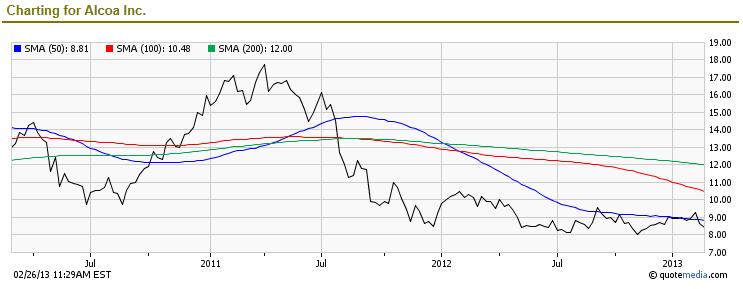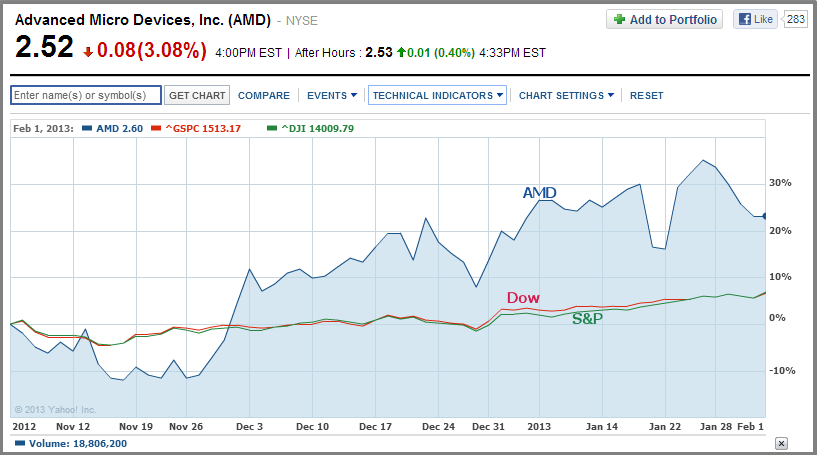- Technical Perspective
(Continuing from: "Is Alcoa Stock (AA) a Buy or Sell? Depends on the Price of Aluminum")
In the last 52 weeks, Alcoa stock (AA) has been trading between a $7.97 and $10.62 bandwidth. Looking at the chart below, it is clear to see that since mid-2011, the stock has been on a steady downward spiral, marking new lows for its 50-day, 100-day and 200-day Simple Moving Averages (SMAs). Since mid-2012 however, the stock seems to be building a steady base for itself around the $8.00 level, only fleetingly breaching its 50-day SMA barrier of $8.81.
Given the current global macroeconomic situation, and realizing that AA has no real ability to influence either Aluminum prices nor its demand, one may find it hard to see what might cause the stock to perform any better than it has over the last 200 days. Should some external (yet unforeseen) situation occur, and if the stock is able to breach its 50-day SMA and build a strong base at those levels for a sustained period of time, then AA may be able to inch up to its 100-day SMA of $10.48.
- Favorable/Negative Catalysts
The biggest headwinds that Alcoa faces is growing competition from newcomers into its space, notably from Russia, China and the Middle East. This is causing a pileup of Aluminum inventory, and with no real pricing power wielded by established players like AA, prices of the commodity are being pushed lower. Add to this the negative catalysts of slowing demand from China and Europe, and you have a recipe for slowing growth for AA.
Energy is a key input into the Aluminum production process, and rising cost of energy can have a dampening effect on profitability. One positive factor for AA is continued low natural gas prices. To capitalize from this phenomena, AA management has been swift to shift production to regions with lower energy costs, including natural gas.
Alcoa's relative size, and its global reach, also act as favorable catalysts for the company. The recent coming on-stream of a joint venture Aluminum smelter in Saudi Arabia for instance is a great example of how AA uses its global network to its advantage. Should global demand for Aluminum recover, the added production capability will provide Alcoa a huge competitive advantage, and could also offer a slight pricing power.
AA faces stiff competition from China in its Bauxite operations. However, a negative catalyst for China is the high cost of energy that Chinese companies have to pay. Strategic moves by Alcoa a few years ago, including the decision to move into high-margin areas such as Bauxite mining in Brazil and Aluminum can sheets in Russia have now positioned the company to capitalize on non-core mining activities. These moves will allow AA to compete by lowering its cost of production by over 25% compared to China.
A big catalyst to AA's stock price might be a possible takeover by a competitor. Persistent rumors continue to surface frequently about such a move, with possible suitors being Rio Tinto and Chalco.
- Bottom Line Conclusion
As one of the Aluminum industry's top players, Alcoa also has a number of other interests, including Alumina production, Aluminum smelting and Bauxite operations. However, Alumina (which is a key component in Aluminum production) is AAs largest business segment, and currently there does not appear to be any major factor that might influence upward movement of the prices of the metal.
For this reason, we would rate AA as a HOLD, with a recommendation that investors with significantly overweight positions consider trimming some on any short-term price spike.
- Market Correction Impact
MarketConsensus would, however, like to caution investors on what we see as an imminent market correction. Market trend indicators are pointing to an overbought situation and a correction is a very real risk over the next 1-2 months. Investors should take this into consideration in their near term investing choices.
(By: Monty R. – MarketConsensus News Contributor)
[related2][/related2]







